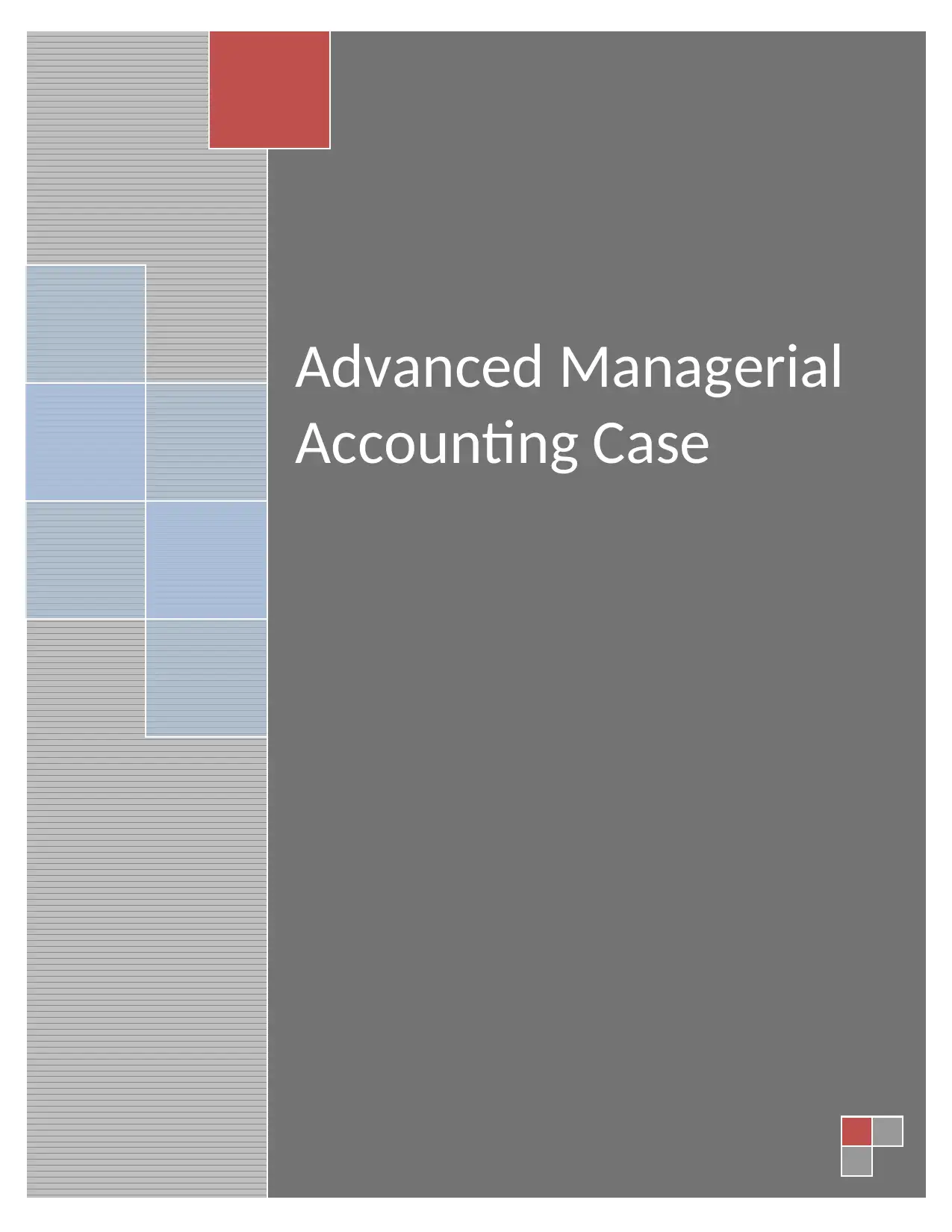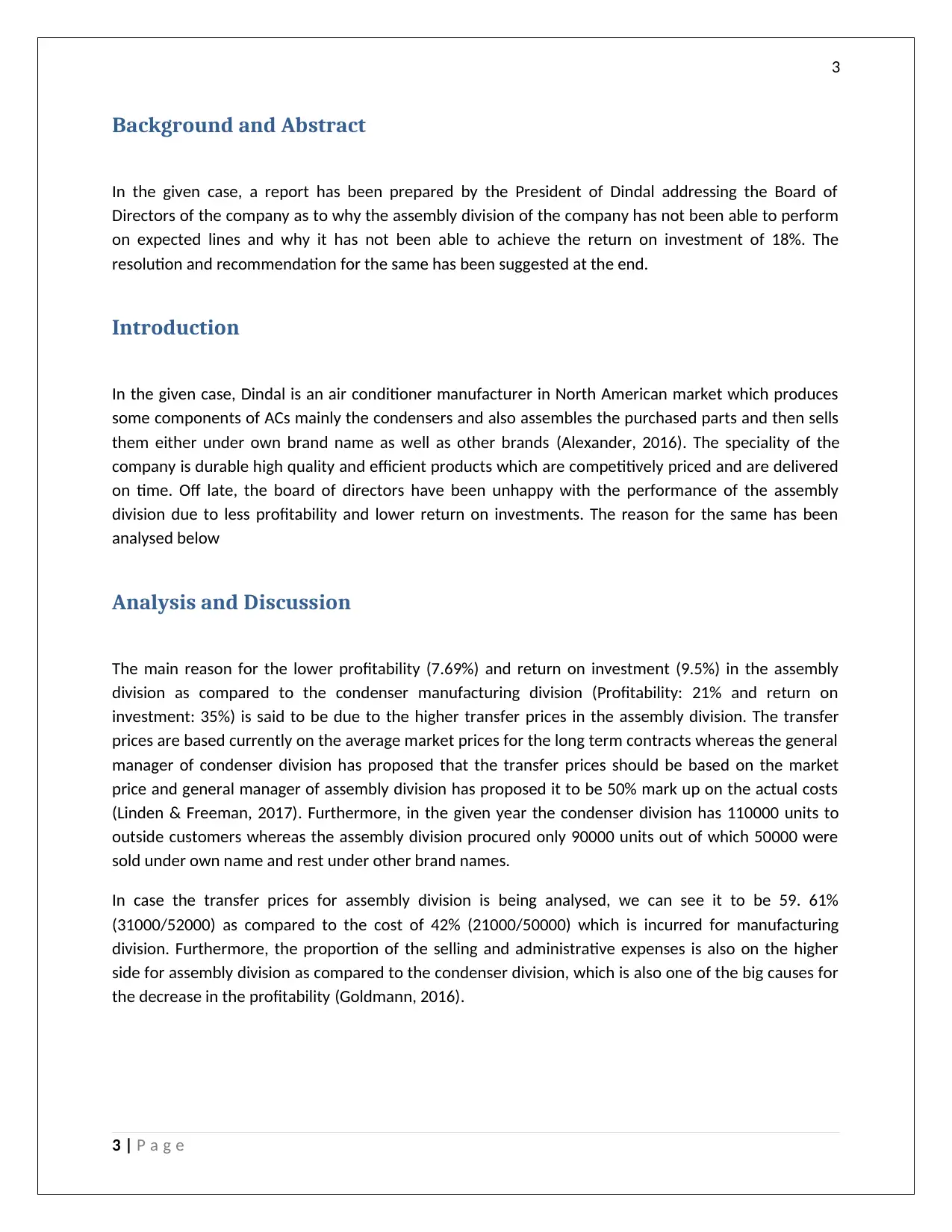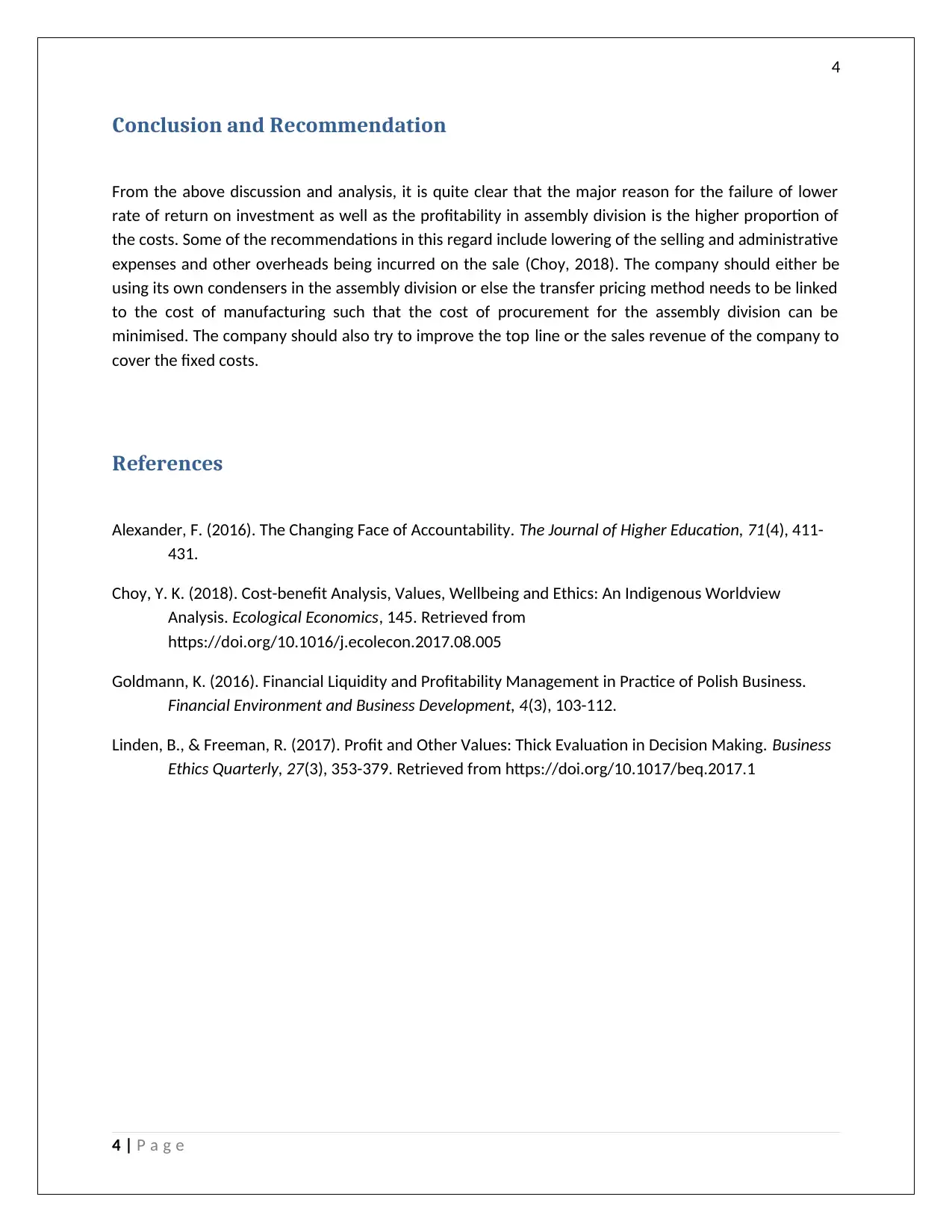Case Study: Dindal Company's Assembly Division Performance Analysis
VerifiedAdded on 2023/05/28
|5
|748
|211
Case Study
AI Summary
This case study provides an analysis of Dindal Company, an air conditioner manufacturer, focusing on the underperformance of its assembly division. The report, addressed to the Board of Directors, investigates the reasons behind the division's inability to achieve the expected 18% return on investment. The analysis identifies higher transfer prices and disproportionate selling and administrative expenses as key factors contributing to lower profitability compared to the condenser manufacturing division. The document concludes with recommendations to reduce selling and administrative expenses, link transfer pricing to manufacturing costs, and improve sales revenue to cover fixed costs, aiming to enhance the assembly division's financial performance. Desklib provides a platform for students to access similar solved assignments and study resources.

Advanced Managerial
Accounting Case
Accounting Case
Paraphrase This Document
Need a fresh take? Get an instant paraphrase of this document with our AI Paraphraser

1
By student name
Professor
University
Date: 25 April 2018.
1 | P a g e
By student name
Professor
University
Date: 25 April 2018.
1 | P a g e

2
Contents
Background and Abstract............................................................................................................................3
Introduction.................................................................................................................................................3
Analysis and Discussion...............................................................................................................................3
Conclusion and Recommendation...............................................................................................................4
References...................................................................................................................................................4
2 | P a g e
Contents
Background and Abstract............................................................................................................................3
Introduction.................................................................................................................................................3
Analysis and Discussion...............................................................................................................................3
Conclusion and Recommendation...............................................................................................................4
References...................................................................................................................................................4
2 | P a g e
⊘ This is a preview!⊘
Do you want full access?
Subscribe today to unlock all pages.

Trusted by 1+ million students worldwide

3
Background and Abstract
In the given case, a report has been prepared by the President of Dindal addressing the Board of
Directors of the company as to why the assembly division of the company has not been able to perform
on expected lines and why it has not been able to achieve the return on investment of 18%. The
resolution and recommendation for the same has been suggested at the end.
Introduction
In the given case, Dindal is an air conditioner manufacturer in North American market which produces
some components of ACs mainly the condensers and also assembles the purchased parts and then sells
them either under own brand name as well as other brands (Alexander, 2016). The speciality of the
company is durable high quality and efficient products which are competitively priced and are delivered
on time. Off late, the board of directors have been unhappy with the performance of the assembly
division due to less profitability and lower return on investments. The reason for the same has been
analysed below
Analysis and Discussion
The main reason for the lower profitability (7.69%) and return on investment (9.5%) in the assembly
division as compared to the condenser manufacturing division (Profitability: 21% and return on
investment: 35%) is said to be due to the higher transfer prices in the assembly division. The transfer
prices are based currently on the average market prices for the long term contracts whereas the general
manager of condenser division has proposed that the transfer prices should be based on the market
price and general manager of assembly division has proposed it to be 50% mark up on the actual costs
(Linden & Freeman, 2017). Furthermore, in the given year the condenser division has 110000 units to
outside customers whereas the assembly division procured only 90000 units out of which 50000 were
sold under own name and rest under other brand names.
In case the transfer prices for assembly division is being analysed, we can see it to be 59. 61%
(31000/52000) as compared to the cost of 42% (21000/50000) which is incurred for manufacturing
division. Furthermore, the proportion of the selling and administrative expenses is also on the higher
side for assembly division as compared to the condenser division, which is also one of the big causes for
the decrease in the profitability (Goldmann, 2016).
3 | P a g e
Background and Abstract
In the given case, a report has been prepared by the President of Dindal addressing the Board of
Directors of the company as to why the assembly division of the company has not been able to perform
on expected lines and why it has not been able to achieve the return on investment of 18%. The
resolution and recommendation for the same has been suggested at the end.
Introduction
In the given case, Dindal is an air conditioner manufacturer in North American market which produces
some components of ACs mainly the condensers and also assembles the purchased parts and then sells
them either under own brand name as well as other brands (Alexander, 2016). The speciality of the
company is durable high quality and efficient products which are competitively priced and are delivered
on time. Off late, the board of directors have been unhappy with the performance of the assembly
division due to less profitability and lower return on investments. The reason for the same has been
analysed below
Analysis and Discussion
The main reason for the lower profitability (7.69%) and return on investment (9.5%) in the assembly
division as compared to the condenser manufacturing division (Profitability: 21% and return on
investment: 35%) is said to be due to the higher transfer prices in the assembly division. The transfer
prices are based currently on the average market prices for the long term contracts whereas the general
manager of condenser division has proposed that the transfer prices should be based on the market
price and general manager of assembly division has proposed it to be 50% mark up on the actual costs
(Linden & Freeman, 2017). Furthermore, in the given year the condenser division has 110000 units to
outside customers whereas the assembly division procured only 90000 units out of which 50000 were
sold under own name and rest under other brand names.
In case the transfer prices for assembly division is being analysed, we can see it to be 59. 61%
(31000/52000) as compared to the cost of 42% (21000/50000) which is incurred for manufacturing
division. Furthermore, the proportion of the selling and administrative expenses is also on the higher
side for assembly division as compared to the condenser division, which is also one of the big causes for
the decrease in the profitability (Goldmann, 2016).
3 | P a g e
Paraphrase This Document
Need a fresh take? Get an instant paraphrase of this document with our AI Paraphraser

4
Conclusion and Recommendation
From the above discussion and analysis, it is quite clear that the major reason for the failure of lower
rate of return on investment as well as the profitability in assembly division is the higher proportion of
the costs. Some of the recommendations in this regard include lowering of the selling and administrative
expenses and other overheads being incurred on the sale (Choy, 2018). The company should either be
using its own condensers in the assembly division or else the transfer pricing method needs to be linked
to the cost of manufacturing such that the cost of procurement for the assembly division can be
minimised. The company should also try to improve the top line or the sales revenue of the company to
cover the fixed costs.
References
Alexander, F. (2016). The Changing Face of Accountability. The Journal of Higher Education, 71(4), 411-
431.
Choy, Y. K. (2018). Cost-benefit Analysis, Values, Wellbeing and Ethics: An Indigenous Worldview
Analysis. Ecological Economics, 145. Retrieved from
https://doi.org/10.1016/j.ecolecon.2017.08.005
Goldmann, K. (2016). Financial Liquidity and Profitability Management in Practice of Polish Business.
Financial Environment and Business Development, 4(3), 103-112.
Linden, B., & Freeman, R. (2017). Profit and Other Values: Thick Evaluation in Decision Making. Business
Ethics Quarterly, 27(3), 353-379. Retrieved from https://doi.org/10.1017/beq.2017.1
4 | P a g e
Conclusion and Recommendation
From the above discussion and analysis, it is quite clear that the major reason for the failure of lower
rate of return on investment as well as the profitability in assembly division is the higher proportion of
the costs. Some of the recommendations in this regard include lowering of the selling and administrative
expenses and other overheads being incurred on the sale (Choy, 2018). The company should either be
using its own condensers in the assembly division or else the transfer pricing method needs to be linked
to the cost of manufacturing such that the cost of procurement for the assembly division can be
minimised. The company should also try to improve the top line or the sales revenue of the company to
cover the fixed costs.
References
Alexander, F. (2016). The Changing Face of Accountability. The Journal of Higher Education, 71(4), 411-
431.
Choy, Y. K. (2018). Cost-benefit Analysis, Values, Wellbeing and Ethics: An Indigenous Worldview
Analysis. Ecological Economics, 145. Retrieved from
https://doi.org/10.1016/j.ecolecon.2017.08.005
Goldmann, K. (2016). Financial Liquidity and Profitability Management in Practice of Polish Business.
Financial Environment and Business Development, 4(3), 103-112.
Linden, B., & Freeman, R. (2017). Profit and Other Values: Thick Evaluation in Decision Making. Business
Ethics Quarterly, 27(3), 353-379. Retrieved from https://doi.org/10.1017/beq.2017.1
4 | P a g e
1 out of 5
Related Documents
Your All-in-One AI-Powered Toolkit for Academic Success.
+13062052269
info@desklib.com
Available 24*7 on WhatsApp / Email
![[object Object]](/_next/static/media/star-bottom.7253800d.svg)
Unlock your academic potential
Copyright © 2020–2025 A2Z Services. All Rights Reserved. Developed and managed by ZUCOL.





